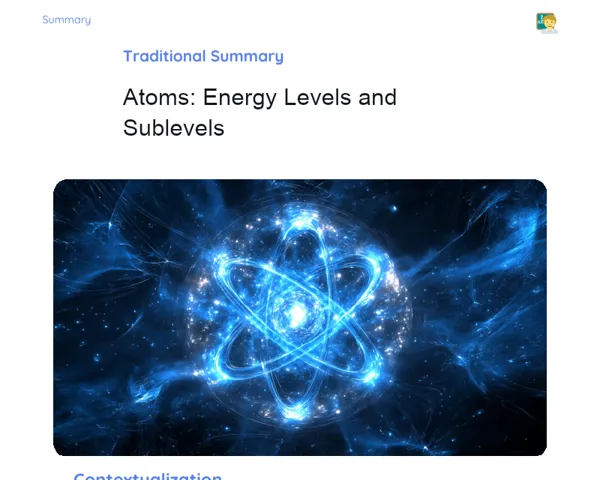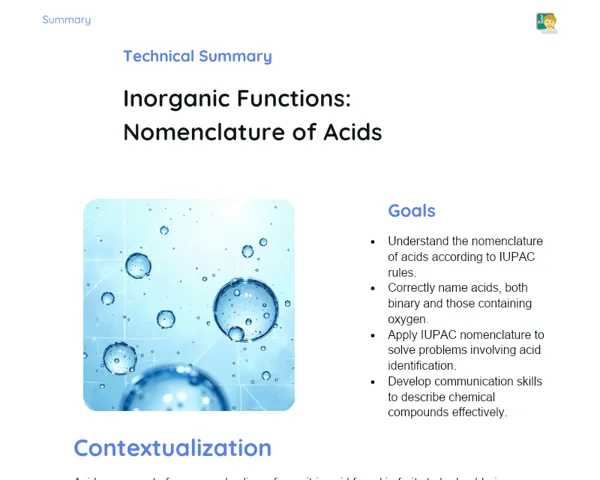Objectives
1. 🎯 Understand the Properties of Elements in the Periodic Table: By the end of this lesson, you will be able to identify and describe important properties of elements, such as electronegativity, and comprehend how they are arranged in the Periodic Table.
2. 🔍 Differentiate Periodic and Non-periodic Properties: Learn to distinguish between properties that display periodic trends and those that do not, which will assist you in predicting the behavior of elements based on their location in the table.
Contextualization
Did you know the Periodic Table we refer to today was proposed by Dmitri Mendeleev in 1869? He devised a system that organizes elements by their atomic masses and, impressively, predicted properties and even the existence of elements yet to be discovered! The table serves not only as a tool for memorization but as a dynamic guide that keeps evolving and is vital for advancements in science and technology. In today's session, we will delve into how you can utilize this remarkable tool to uncover the properties of elements and understand how they influence everything around us.
Important Topics
Electronegativity
Electronegativity measures an atom's ability to attract a pair of electrons in a chemical bond. This periodic property is key to understanding how elements interact and form compounds. Electronegativity rises from the bottom to the top of a group and from left to right across a period in the Periodic Table.
-
Electronegativity affects the polarity of chemical bonds; elements with high electronegativity typically create polar or ionic bonds.
-
Differences in electronegativity among various elements can help predict the type of bond they will form and the stability of a compound.
-
Elements like fluorine possess the highest electronegativity, making them highly reactive and capable of forming robust bonds with other elements.
Atomic Radius
The atomic radius indicates the average distance between an atom's nucleus and its outer electron shell. This non-periodic property varies notably among elements and is critical for understanding atomic structure and chemical interactions.
-
The atomic radius decreases across a period as the number of protons increases, pulling electrons closer to the nucleus.
-
In groups, the atomic radius increases with the addition of electron shells, as each new shell extends further from the nucleus.
-
Grasping the atomic radius is vital for forecasting an element's reactivity, as elements with larger atomic radii generally lose electrons more readily.
Electron Affinity
Electron affinity refers to the energy released when a neutral gas-phase atom gains an electron to form a negative ion. This property is an excellent predictor of an element's reactivity, especially in ion-forming reactions.
-
Elements with high electron affinity, like halogens, are incredibly reactive and have a strong inclination to gain electrons.
-
Electron affinity may inversely correlate with atomic radius; smaller atoms generally exhibit higher electron affinity.
-
Comprehending electron affinity aids in predicting the products of chemical reactions and the stability of formed ions.
Key Terms
-
Periodic Table: A tabular representation of chemical elements, organized by atomic number, electronic configuration, and recurring chemical properties.
-
Electronegativity: A measure of an atom's tendency to attract electrons in a chemical bond.
-
Atomic Radius: The average distance between the nucleus of an atom and its outermost electron shell.
-
Electron Affinity: The energy released when a neutral gas-phase atom gains an electron.
For Reflection
-
How does an element's position in the Periodic Table signify its chemical and physical properties?
-
Why is electronegativity crucial for determining the type of chemical bond that an element can form?
-
In what ways do the periodic and non-periodic properties of elements impact their practical and industrial applications?
Important Conclusions
-
Today, we explored the intriguing world of the Periodic Table and its properties, including electronegativity, atomic radius, and electron affinity. These properties are not just figures; they have tangible implications in our world, from compound formation to applications in industry and the environment.
-
Identifying and differentiating between periodic and non-periodic properties enhances our chemical understanding and boosts our ability to predict and manage chemical reactions to address practical challenges.
-
Electronegativity, for instance, plays a vital role in determining bond types and molecule stability, which is essential for everything from the development of new materials to comprehending biological processes occurring within our bodies.
To Exercise Knowledge
- Element Map: Create a conceptual map linking different elements with their periodic and non-periodic properties. Include examples illustrating how these properties affect chemical reactions.
- Properties Quiz: Prepare a quiz to challenge your classmates on the properties of elements in the Periodic Table. Include questions about electronegativity, atomic radius, and electron affinity.
- Atom’s Diary: Write a creative diary entry from an atom's perspective, detailing its 'day' based on its chemical properties and the interactions it experiences.
Challenge
🎯 Chemical Detective Challenge: Using only periodic properties, attempt to predict the reactivity of an unknown element and describe the types of chemical reactions it might participate in. Present your predictions in a short video or presentation for the class!
Study Tips
-
Utilize visual aids like videos and infographics to better understand the organization and trends of the Periodic Table. This will make it easier to memorize and grasp the properties of the elements.
-
Summarize what you've learned after each class session and discuss it with your peers or tutors to reinforce your understanding.
-
Investigate augmented reality apps or online simulators that allow you to interact with the Periodic Table in innovative and educational manners, making learning more dynamic and engaging.


